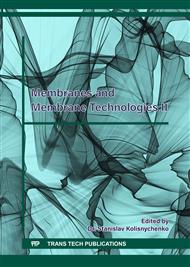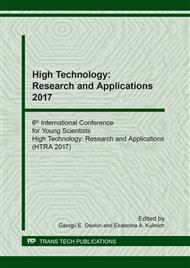[1]
V.Ya. Rudyak, S.L. Krasnolutskii, The calculation and measurements of nanoparticles diffusion coefficient in rarefied gases, J. Aerosol Science. Vol. 34, suppl. 1. (2003) 579-580.
Google Scholar
[2]
Rudyak V.Ya., Krasnolutskii S.L., Ivanov D.A., The interaction potential of nanoparticles, J. Dok. Phys. Vol. 442, No. 1 (2012) 54–56.
Google Scholar
[3]
V. Ya. Rudyak, A. A. Belkin, V. V. Egorov and D. A. Ivanov. About fluids structure in microchannels. International Journal of Multiphysics.2 (2011) 145–155.
DOI: 10.1260/1750-9548.5.2.145
Google Scholar
[4]
A.M. Bubenchikov, M.A. Bubenchikov, A.I. Potekaev, E.E. Libin, Y.P. Hudobina, Potential field of carbon bodies as basis for sorption properties of barrier gas systems, News of Higher Educational Institutions. Physics. 58 (2015) 87-94.
DOI: 10.1007/s11182-015-0586-6
Google Scholar
[5]
M.A. Bubenchikov, A.I. Potekaev, A.M. Bubenchikov. Thermophoresis of ultrafine and nanosized particles. Russian Physics Journal. 56 (2013) 785-790.
DOI: 10.1007/s11182-013-0100-y
Google Scholar
[6]
M.A. Bubenchikov, A.I. Potekaev, A.M. Bubenchikov. A scheme for hydrogen evolution from natural gas. Applied Mechanics and Materials. 698 (2015) 525-528.
DOI: 10.4028/www.scientific.net/amm.698.525
Google Scholar
[7]
A. M. Bubenchikov, M. A. Bubenchikov, O. V. Matvienko, E. A. Tarasov, O. V. Usenko, Simple energy barrier for component mixture of natural gases, AIP Conference Proceedings. Vol. 1698, Article number 060007 (2016) 4 p.
DOI: 10.1063/1.4937862
Google Scholar
[8]
M. A. Bubenchikov, A. I. Potekaev, A. M. Bubenchikov, O. V. Usenko, A. V. Malozemov, E. A. Tarasov, The interaction potential of an open nanotube and its permeability: molecular dynamics simulation, EPJ Web of Conferences. Vol. 110, Article number 01061 (2016).
DOI: 10.1051/epjconf/201611001061
Google Scholar
[9]
E. A. Tarasov, Y. P. Khudobina, Interaction between hydrogen molecules and a closed nanotube, MATEC Web of conferences. Vol. 72. – Article number 01044 (2016) 4 p.
DOI: 10.1051/matecconf/20167201044
Google Scholar
[10]
Tarasov E. A. Interaction potential of open carbon nanotube with natural gas molecular components, Key Engineering Materials. 685 (2016) 534-538.
DOI: 10.4028/www.scientific.net/kem.685.534
Google Scholar
[11]
Tarasov E. A. Interaction of carbon-based nanoobjects with components of natural gas: Extended abstract of PhD dissertation (Phys. and Math.), Tomsk State University, Tomsk, 2017. (in Russian).
Google Scholar



